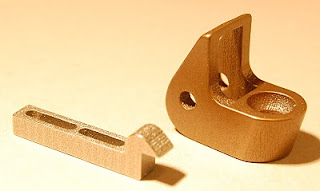 Man, that Shapeways stainless steel is pretty.
Man, that Shapeways stainless steel is pretty.I got my second delivery from Shapeways today, and it had the two metal parts: the screen door catch cast in stainless steel, and the dining room table caster printed in stainless but with a bronze finish. Both are well-finished, precise, and smooth - although the photo might make it look like the parts have print lines, the parts actually feel smooth. The larger latch piece is 1.5 inches long, so that'll give you a sense of how fine the metal 3d printing can be.


 First step: reassemble the table caster. The part's pretty much perfectly finished straight from the box, but I sized the axle hole a bit small so I could drill it to the diameter of the axle. I was a bit worried about this; stainless steel is usually a horrible material to drill or machine because the metal at the surface hardens as it's cut; if I cut the stainless steel evenly removing a bit each time the drill spins, it'll drill fine, but if I don't advance the drill bit far enough, the metal will harden because of the pressure of the tool, the tool will stop cutting, and I'll have to push lots harder to drill through the casting. Traditionally, this is described as a weird "ka-thunk!" with the drill not cutting, then suddenly grabbing on the metal when enough pressure's added to cut the metal.
First step: reassemble the table caster. The part's pretty much perfectly finished straight from the box, but I sized the axle hole a bit small so I could drill it to the diameter of the axle. I was a bit worried about this; stainless steel is usually a horrible material to drill or machine because the metal at the surface hardens as it's cut; if I cut the stainless steel evenly removing a bit each time the drill spins, it'll drill fine, but if I don't advance the drill bit far enough, the metal will harden because of the pressure of the tool, the tool will stop cutting, and I'll have to push lots harder to drill through the casting. Traditionally, this is described as a weird "ka-thunk!" with the drill not cutting, then suddenly grabbing on the metal when enough pressure's added to cut the metal.Luckily, the Shapeways sintered metal cut drilled smoothly and easily, so getting the axle hole square and the right diameter wasn't hard.
The original axle (only a hundred years old!) was bent, so I knew I needed a new one. The old one had both ends of the rod hammered wide to hold the wheels on, meaning that the caster couldn't be disassembled without cutting the axle. Instead, I wanted to make sure I could remove the axle if I needed to disassemble the caster. Because the wooden wheels are 100 years old (and already have flat spots), I suspect I'll need to replace those some day. For the replacement axle, I borrowed a 3/16" diameter stainless steel pin intended for trailer hitches; one end already had a wide head, and I shortened the pin with my trusty hack saw and cut a slot with my lathe for an E-ring to secure the wheels on the axle using a parting tool. I then drilled out the axle hole just larger than the axle. The axle got reassembled - pin, wheel, printed part, wheel, and E-ring - and out broken hundred year old caster is ready to go back onto the table.
Pics of the fixed table later.
 The caster broke when we refinished the dining room table a few years ago. The guy doing the work was apologetic, and searched for a matching caster without much luck. I remember thinking at the time that I could probably machine a new part, but I knew it would be a challenge to get the dimensions right and get the work suitably precise. I'd even thought at the time I ought to learn about bronze casting, but really didn't need an excuse for another hobby.
The caster broke when we refinished the dining room table a few years ago. The guy doing the work was apologetic, and searched for a matching caster without much luck. I remember thinking at the time that I could probably machine a new part, but I knew it would be a challenge to get the dimensions right and get the work suitably precise. I'd even thought at the time I ought to learn about bronze casting, but really didn't need an excuse for another hobby.Fast forward three years, and access to the Makerbot and Shapeways made replacing the part easy. Without the Makerbot, I wouldn't have been able to experiment with shapes and test that the printed piece would fit and function correctly. Without Shapeways, I wouldn't have been able to print the new part in a material strong enough to hold up the table. Without both - a handy, personal 3d printer, and a way to print in exotic materials, we'd still have a broken table.
Thanks, Makerbot and Shapeways!
That turned out really well!
ReplyDeleteGlad to see drilling the SS works better with larger drill bit diameters; small holes are the opposite.